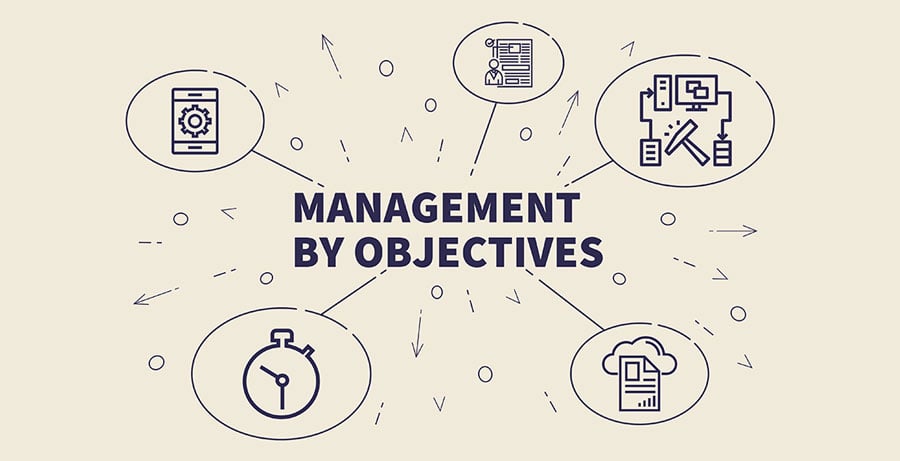Management by objectives is a managerial model which emerged in the 1960s and which does not concern only strictly qualitative objectives. The mechanism for calculating bonuses through MBO tends to be associated with qualitative fields rather than quantitative fields, but in reality management by objectives covers all types of variables and metrics that can be evaluated.
MBO APPLIES TO DIFFERENT SECTORS WITH DIFFERENT REQUIREMENTS
In principle, MBO can be used in different sectors. However, there are different requirements depending on the nature of the sector. A distinction is made in terms of what is expected of employees: are they responsible for the immediate result or for creating tomorrow’s result? The answer to these questions forms a clear dividing line in the implementation of MBO. If an employee’s place in the company and his role and impact primarily involve delivering results, the manager will have little need for qualitative objectives and scorecards like MBO. The employee is “focused” and the company expects him to deliver an economic result in any form whatsoever. The form of the expected turnover also depends on the company’s sector of activity.
In the same way, the less the employee’s role directly impacts economic performance, but conversely has a real impact on the creation of the conditions for future success, the more of a shift there is away from purely quantitative and economic variables towards more qualitative considerations. In this way, ultimately the share of qualitative considerations and the most common MBO methods are found among head office staff, especially management committees which are in part indirectly responsible for economic performance.
MBO applies to all inside and non-sales staff
There is still an MBO model among all non-sales and inside employees. Alongside collective economic variables and insofar as business units do not have the capacity to deliver a customisable economic result, the results of one business unit are aggregated to the subsidiary’s collective result. Indeed, it is difficult to directly individualise results obtained collectively by a subsidiary which has been set an overall objective.
However, some business lines are essentially based on a bonus system which deploys an MBO model with specific and adapted objectives. All companies thus offer MBO models to their inside employees.
Bonus schemes based on MBO schemes are rarer among sales staff
Sales staff are focused on achieving economic performance and are therefore very much involved in turnover. Nevertheless, the evolution of sales professions means we should ask ourselves what the purpose is of supplementing their variable pay scheme with something other than immediate results, thereby focussing on value creation in its entirety.
Over the past two decades or so, we have seen a real professionalisation of sales functions. Today, the general view is that sales staff cannot be expected to work on economic performance alone. In France in particular, there is a slightly more pejorative view of sales roles compared, for example, to Anglo-Saxon countries, where sales professions – based on individual and economic success – are highly respected. Sales positions, although a little more respected in international markets, have become “functionalised” to a large extent. For example, sales staff are required to apply techniques, technologies and know-how, meaning they are decreasingly responsible for results independently of support functions.
Commercial transactions themselves now depend more and more on the interaction of staff in multiple roles. These include a “pure” salesperson, a key account manager, a sales technician who deploys solutions, and customs success managers in charge of up-selling sales to the customer. In this way, sales success is less and less fully customisable.
WHAT ARE THE BENEFITS OF MBO?
MBO encourages staff with complementary skills to collaborate
Collaborative work can be introduced through collective mechanisms based on quantitative variables, but it can also be introduced through qualitative variables to induce behavioural change. The key to success in many fields today lies in the ability of the same team to work collaboratively towards the same objective, yet with complementary roles. It is important to stress that the mechanism of collaborative work does not come naturally and companies must set up incentive mechanisms that encourage collaboration, value it and recognise it. This is an important aspect in the transformation of the skills models that need to be established today in companies.
One of the benefits of MBO is the possibility to combine different areas of performance, which combine multiple aspects that are somewhat broader in scope than the mere delivery of a given result. The areas concerned involve professional development, which are particularly relevant if, for example, the model in question includes rare skills and in principle does not come under the scope of variable pay.
Developing rare, behavioural or cross-functional skills through MBO
MBO goes hand in hand with the change of skills model in different bonus schemes. It does not necessarily produce immediate results, but allows a category of objectives to be chosen in line with each employee’s expectations and profile.
Objectives are thus proposed to each of the beneficiaries for a specific group of employees and cover different aspects. In the example of collaborative work, the employees involved are not necessarily all at the same level. For example, at a given moment, in a team of around fifty salespeople there are different levels of skills in terms of effective teamwork. This issue may be common to all the members of the same team, although there may be different requirements, especially between employees who already excel in this area and those who still struggle to share important information with their colleagues – relevant information that needs to be shared for the overall performance of the sales team. The manager will have very different requirements for these two different profiles. In this context, the MBO method allows the manager to choose which issue to put forward to each employee, and also to choose the specific requirement that he sets for each one. This is a process involving the personalisation of individual objectives according to each employee’s profile, and targets in terms of the global development strategy of the entity and the company as a whole.
Management by objectives is not always linked to a financial bonuses scheme
MBO is not always linked to a bonus scheme and it does not mean that there is a bonus scheme thrown into the bargain. Managers can decide to include money as a bonus, or can decide not to, at least in the form of financial bonuses. In companies, a large number of people are motivated through a system of targets set at the beginning of the year with the managers, without being part of a bonus scheme.
The manager specifically focuses on whether the job is done correctly and proposes, for example, a change in basic pay, or career development to the employee rather than a response in the form of bonuses. MBO is one possible form of variable pay, so there is not necessarily an obligation to implement a bonus system as well.
MBO encourages collaborative objective-setting between employees and managers
MBO has the advantage of being able to establish a collaborative approach. When objectives are set at each level of an organisation, this must be the result of the objectives of the level above. There is therefore a system for stating the issues facing a company: in the case of a highly standardised system such as the scorecard, there is no possible discussion on the objectives ultimately set. However, it may be possible to work out with a scorecard working group, i.e. the company may offer all employees it is targeting, and each of the individuals concerned, the possibility of discussing the nature of the objective and the level of requirement imposed.
In an MBO system, a company can therefore decide to full embrace joint objective-setting for a given issue or an individual need for progress on a specific subject. The employee, in a discussion with his manager, can help set the objective but also the requirement to be assigned to him. This collaboration must be carried out without any grandstanding and give the employee the chance to have an open and sincere discussion with the manager who is responsible for setting the objectives and evaluating them. The discussion on the nature of the objectives to be set, if it is done on good terms, is a great way to encourage teams to commit more to an objective proposed to them. The joint setting of objectives enabled by the MBO method is thus a real benefit and has every chance of being fruitful in terms of substance. It offers the chance to decide on the best kind of objectives and the requirements that should be set for a given employee.
Collaboration is all the more important when it comes to qualitative objectives. It is of some benefit, in particular because of its ability to get teams to adhere to the proposed objectives. In a system of joint objective-setting, both stakeholders, the company and employee, must have the same concerns in order for it to work. However, when a bonus is thrown in, their concerns may be different and the discussion time longer.
WHAT ARE THE PITFALLS OF MBO?
Cascading of the approval of objectives: the danger of inconsistency in how the issues facing a company are defined
In terms of management, MBO can be quite cumbersome to implement and monitor. The “cascading” system described above assumes a company is equipped, and this applies especially to large companies. Indeed, setting individual objectives for a workforce of 300, 400 or 500 people can be difficult, particularly if one wishes to do so rigorously, ensuring that company issues are correctly defined and translated into each layer of the organisation. The company must implement a consistency check and be equipped with the necessary tools. These include the introduction of successive approval processes by the higher hierarchical levels to set a rational and intelligently calculated turnover objective.
Thus, when setting objectives in a more qualitative field, the approval “cascading” must be consistent. A company wishing, for example, to acquire three new products in the next five years, will have to break down this general management objective into various coherent objectives for the development teams to achieve it. It will also have to provide the marketing teams and product teams with the necessary resources (when they are found), and define the missions and objectives assigned to each of the stakeholders involved in achieving this general objective. The company therefore needs to set up coherent cascading, based on the approval of the objectives that will have been assigned to each of the organisational levels. It must ensure that the objectives set at each level are consistent with those set above and that their approval is in line with an established procedure.
Does HR ensure consistency in the setting of objectives under MBO?
HR departments guarantee the correct application and coherence of the cascading of objectives as part of management by objectives. Nevertheless, within a company’s system, each layer of the organisation is responsible for its own level of responsibility.
The real risk in establishing MBO lies in its outcome: this system is so cumbersome that all employees end up having the same level of requirements and the same level of objectives. In this situation, the company misses the raison d'être of MBO: the individualisation and personalisation of objectives.
As such, when implementing MBO, two important aspects come into play: the time spent implementing it, to that extent that it is quite cumbersome to implement, and the managerial courage required of managers, who must not hesitate to differentiate between the objectives of each individual. Managerial courage is essential for the success of MBO: managers must not be afraid to look their employees in the eye and tell them the nature and level of their requirements, and to tell them that there will be no bonuses for personal achievements.
Implementing MBO involves resources and time, so if a company wants it to have a real impact on employee motivation, it must be sure about several different aspects. First of all, the characteristics taken into account within the systems must be of a certain value and provide real added value in the pursuit of the objectives set. Secondly, it must ensure that the objectives are correctly translated into each level of the organisation: the risk is that the same level of objectives is set for all employees, whereas for half of them this makes no sense, even if they have already been under this system of objectives for a relatively long time.
The aim for the company is to avoid a “lukewarm” result, with no real stance and a general model that applies to everyone with no distinction according to the challenges of each position. To avoid this completely incoherent situation, organisations need to have the courage to differentiate between each person’s objectives and ensure that they are properly approved.
Which tool should be used to implement management by objectives?
Companies need a tool which is capable of documenting all the processes implemented, and in particular of managing the different chains for approving objectives: both in the downward flow of objectives and in the reporting of evaluations. This tool must also be able to centralise the various workflow tools, which can be relatively cumbersome and include several different levels of approval. One of the most common pitfalls encountered when setting up these rather cumbersome processes is the late communication of objectives to employees. They may be informed and notified of the annual objectives they have to meet only halfway through the year!
Management by objectives is of benefit regardless of any notion of bonuses, as it obliges entire organisations to express, clarify and share their roadmap irrespective of bonus schemes.
Implementing MBO is in itself a virtuous process. It requires companies to clarify the issues at stake and to define them for all employees. It is in itself meaningful. It gives everyone a roadmap and a precise framework of requirements. Thinking about the setting of personalised objectives is an exercise that is never completely finished. Many questions are unanswered: should a company opt for motivational methods with or without bonuses? Which employee groups will be placed under an MBO system? This virtuous questioning is also valid for the implementation of scorecards insofar as it forces companies to ask themselves the right questions, particularly during the consultation phases. Although in practice MBO is not implemented as comprehensively as one might wish or in the ideal time frame, this type of process remains virtuous as such, regardless of the condition of bonuses.
The weight of the qualitative share on overall variable pay, and its breakdown, is a strategic choice for companies. When MBO represents 50% of the bonus plan for certain inside employees, it is slightly lower and between 20% and 40% for sales staff.
HOW DOES MBO APPLY TO KEY ACCOUNTS MANAGEMENT TEAMS?
CEOs of a large company may be confronted with a target for turnover, increased activity or the acquisition of additional companies. In this case it is easier to rest on concrete economic variables rather than purely qualitative variables.
Until around fifteen years ago, MBO did not exist; today it is increasingly appearing among managerial staff, including in sales sectors. These employees are thus faced with significant qualitative components, which often take the form of MBO.
Moreover, what with the professionalisation and refinement of the sale process, the end result alone is not enough. If we take the case of key account managers working in markets that operate on the basis of calls for tender, we can no longer simply tell a sales representative the fact that he has won or lost a call for tender. First of all, he is rarely the only one to have been involved in an issue, and in most situations, he is not the one who set the price to respond to the call for tenders. Thus, he cannot be held fully responsible for losing or winning the bid since several people were involved in the sale process. Conversely, he is solely responsible for the tasks assigned to him, particularly if he did not correctly carry out certain steps relating to the formulation of the response to the call for tenders. Various questions may be asked. For example, was the response file prepared correctly? Was it completed properly and on time? Was the deadline for replying to the call for tenders met? Did the sales representative work effectively with the leaders of the decision-making panel for the tender in question during the two years prior to the decision?
None of these different aspects are a guarantee for the sales representative that the tender will be won or lost on the day it is issued. However, one thing is certain: if he has not taken all of these measures correctly beforehand, regardless of the quality of the response on D-Day, the tender will be lost because all of the conditions for success will not have been established.
Variable pay should create incentive effects for employees
The ability to motivate employees to adopt new behaviours is the only thing that should guide a company with regard to variable pay: the aim is to encourage people to do, or not to do, new things. Variable pay is not just about increasing turnover or sales margins. Before observing changes in these economic variables, changes in the behaviour of employees, who are more motivated to achieve their objectives, are first observed. Thus, a department turnover that has not progressed to the expected level or that is of a different quality and therefore has not established immediate success, does not mean that it will not contribute to tomorrow’s success.
Employee motivation: at the heart of variable pay schemes
One of the most common experiences when setting up an MBO scheme is that in the end the same objectives have been set for everyone with the same level of requirements. The process of consulting the managerial capacity to establish a team’s objective is not insignificant. This work takes up the manager’s time and energy, and when the content of the cascading of objectives is ultimately found to not differentiate between or personalise objectives enough due to a lack of managerial courage, time or rigour, the expected incentive effects are inevitably missing. The final objectives are not differentiated enough, and the same objectives and final results are allocated among all employees. The system will consequently have required a lot of energy and investment only not to create the expected incentive effects in the end.
Regardless of the methods and channels used, motivation through variable pay arises from only one thing: the co-existence of the risk of losing with the prospect of winning. Depending on the business lines and sectors of activity, these two parameters may express relatively different things. Nevertheless, once an individual is eligible for a variable pay scheme, the question arises as to what motivates him to act differently, what prompts him to change his action plan and to choose to focus his energy on one issue over another. Here it is not a question of analysing whether the employee is happy or unhappy at work, but rather of determining his level of satisfaction: is he satisfied with the situation? What could motivate him to act and work differently?
Team management is not done with variable pay. Variable pay is one of the many tools managers can use and constitutes 1% of a manager’s work. However, it can represent 20% of obstacles to team movement, especially if it is poorly designed. To bring about a change in behaviour, variable pay must be able to make people win or lose. If, in the end, variable pay schemes are identical for all employees and there is no differentiation, the company will have missed out on the hoped-for and expected effects of introducing a bonus scheme. Allocating the same results to everyone under a variable pay scheme is a waste of time, so it is wiser to allocate fixed additional pay to everybody, without investing time, energy and funding in the implementation of a variable pay strategy. If a company decides to introduce variable pay, it must be irreversible and differentiated among employees: as mentioned above, this presupposes a certain amount of managerial courage to set objectives of a different nature and degree for each individual, while always representing the same level of challenges and difficulties.
By setting objectives that are equally difficult for all employees, there is no reason why 100% of employees should be on target in the final evaluation. Half of them should be above, and half slightly below with employees more or less close to the average, so there must be differentiation.
Qualitative bonus schemes and outperformance: a difficult measure
For qualitative bonus schemes, and therefore MBO schemes, there is a tendency to move up the target-setting ladder less for two reasons: the notion of outperformance on the one hand, and the evaluation of objectives by managers on the other.
Firstly, the notion of outperformance based on qualitative criteria is harder to measure, and may even be counterproductive in some circumstances. Take for example a manager who asks his employee to launch three marketing campaigns to generate leads, but the employee decides to launch 10. The employee will first literally “break” the marketing budget, and moreover, the manager will not necessarily have the sales staff necessary to turn all the leads into sales.
The company will therefore have spent a certain amount of money on these multiple marketing campaigns with no end in sight. This example is a perfect illustration that the notion of qualitative objectives is not processed in the same way as a more quantitative notion. Indeed, if a salesperson is asked to make 100,000 euros in turnover, and he makes 300,000, it is not impossible that the company has insufficient industrial apparatus behind it to produce the results and be able to deliver. The company may enjoy a certain flexibility in certain situations, and sometimes it will be harder for it to meet its commitments. Companies do not necessarily have the same need for incentives for exceptional performance, but they must know how to provide incentives in the development of their variable pay strategy.
The second aspect to take into account is the evaluation of objectives by managers. MBO is part of a system involving evaluation by managers, who have to assess how well a particular objective is fulfilled. The system should not “be a bad influence”: the impact of varying differentiation should not be too great. If it is, managers are discouraged from being too brave. In this way, the bonus awarded cannot go from 0 to 100 without intermediate steps: it is difficult for a manager to tell someone who has not fully achieved his objective that he will not get even a small bonus. Without the possibility of differentiation, the evaluation system is too rigid, which puts managers in difficulty more and, paradoxically, causes them to be less courageous. Indeed, when evaluating an employee’s results, managers first think in terms of the impact of losing the bonus.
A longer time frame: MBO takes time to be properly implemented.
The MBO scheme can take a relatively long time to set up and is more time-consuming than other variable pay schemes. Performance cycles are longer than those found when evaluating purely economic variables.
On average, MBO is implemented annually for managerial staff, while for sales staff it may be reduced to six-month intervals. For most employee groups, the principle of “cascading” the priorities of their company’s action plan is used, which inevitably involves a longer time frame than when setting simpler objectives. If, for example, an employee is set the objective of achieving a 5% increase in turnover with a deadline before the end of the year, it will be possible to time his progress as and when he progresses, in particular by introducing successive sprints.
When MBO and an action plan with objectives of a more qualitative nature are implemented, companies need a certain amount of time to succeed in applying it to all levels of the organisation rigorously and effectively. Large companies with a significant number of employees exercising different functions and roles must therefore take the time to set consistent qualitative objectives for all their employees. Furthermore, to meet these medium-term challenges, it is also necessary to ensure that the different teams and beneficiaries are given the time to implement the objectives set for them. Such MBO is based on performance cycles of at least one year, which may extend to three years specifically with the setting of intermediate objectives. These contribute to better employee loyalty and retention and encourage employees to stay until the end of the cycle.





